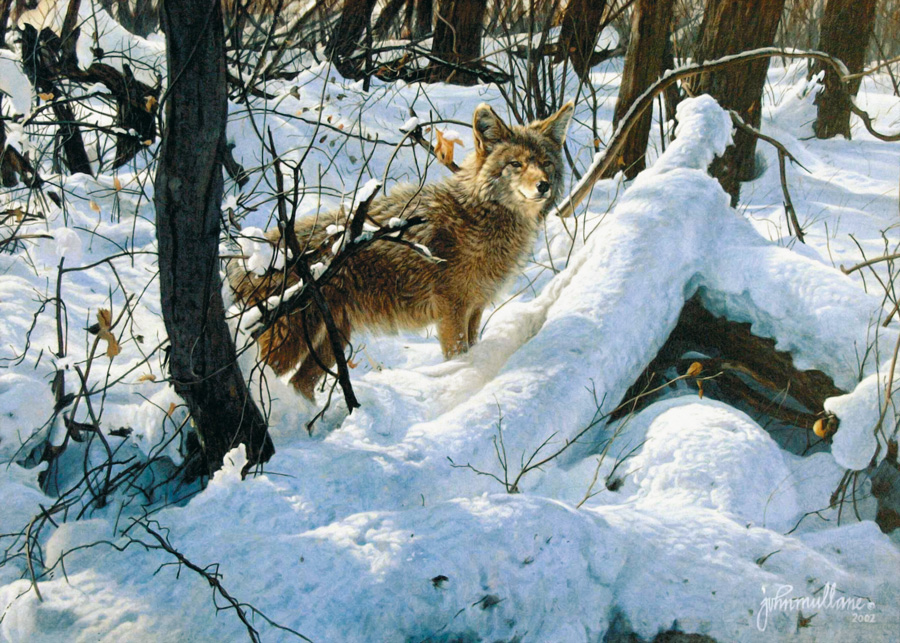NJ Fish and Game report on Eastern Coyotes in the Garden State
Coyotes in New Jersey
1500 to 3000 Coyotes in NJ as of 2014
The first known record of coyote occurrence in New Jersey was recorded near Lambertville, Hunterdon County in 1939. The animal was described in newspaper accounts as "a long, bushy tailed animal looking something like a police dog but with the coloration of a coyote". The mounted skin is in the collection of theNew Jersey State Museum in Trenton. The Division of Fish and Wildlife received another 29 reports statewide sporadically over the ensuing 40 years, but increased significantly since 1980.
To date, coyotes have been documented in nearly 400 municipalities from all 21 counties (94% of the state's land area): | |

A healthy NJ coyote is sometimes mistaken for a wolf.
|
Eastern coyotes differ from their western counterparts with a larger average size and various color phases, including blonde, red and black. Past interbreeding between wolves and coyotes may be responsible for the larger size and color variations in our eastern coyote. In New Jersey, adult coyotes range in weight from 20-50 lbs. and exceptionally large ones may be up to 55 lbs. Coyotes adjust well to their surroundings and can survive on whatever food is available. They prey on rabbits, mice, birds and other small animals, as well as young and weakened deer. They also consume carrion (decaying tissue). They are tolerant of human activities and rapidly adapt to changes in their environment.

Eastern coyotes differ from their western counterparts with a larger average size and various color phases, including blonde and black.
|
|
Coyotes play an important role in the ecosystem, helping to keep rodent populations under control. They are by nature wary of humans. However, coyote behavior changes if given access to human food and garbage. They lose caution and fear. They may cause property damage and threaten human safety, requiring euthanasia. Relocating a problem coyote is not an option because it only moves the problem to someone else's neighborhood.
|
| 
Past interbreeding between wolves and coyotes may be responsible for the larger size and color variations in the eastern coyote. |
-----------------------------------------------------------------------------------------------------------------
he Life Of Wiley
By Melinda Nye
The Eastern Coyote (Canis latrans var) has been spotted in every county in the state. Over thirty years New Jersey's coyote population has grown exponentially, from less than 100 to an estimated 3,000 animals. In northern New Jersey, the most concentrated populations have been found in Sussex county and the western halves of Passaic, Morris and Warren counties.
Remarkably, few people notice the wild canine in their midst. Their myopia stems in part from coyote's resemblance to a shy dog. The size of a small German Shepherd, the Eastern Coyote measures four to five feet in length. While larger specimens reside in the Adirondacks; the smaller New Jersey coyotes typically weighs thirty-five to forty-five pounds. Their shaggy fur ranges from a blond-gray to a dark brown that appears almost black. Most people get little more than a quick view of the tail end disappearing into cover, which provides the only clue to the creature's identity; unlike a dog, the coyote carries its droopy, bushy tail downwards.
"Coyote in Winter" by wildlife artist John Mullane.
Human development - with its accompanying refuse and disruption of habitat makes surprisingly good coyote habitat. If, in a northern forest, a coyote might claim a territory as large as 62 square miles, a suburban coyote can thrive in a territory that measures a scant five square miles.
It was only a matter of time before coyotes ambled, swam and leaped in to New Jersey. If the eastbound lane had closed down, they would have arrived on the southbound. Both Pennsylvania and New York estimate their coyote population at about 30,000 animals: 30,000 wily, highly adaptable, long-ranging animals. Increasingly comfortable with humans and not averse to travel, coyotes have swum to islands off Massachusetts. One was caught in Manhattan. Northern New Jersey must have been a no-brainer, like falling in love with the attractive neighbor.
Allan Sampson, a farm manager who takes care of several hundred acres in Somerset and Hunterdon counties, has worked around coyotes for eighteen years. Of the vocal group that has staked a claim along Lamington Road, he says only "they've been behaving themselves. They mind their own business. They're not causing any problem, like bothering livestock or chasing pets or people." He pauses. "Coyotes get a bad rap. Just recently they were blamed for killing sheep. It didn't sound right when I heard an ear was chewed off. Turned out it was the neighbor's dogs. Every time the dogs got loose they made a beeline for the sheep."
The coyote might just be here to stay. According to the DEP, New Jersey can potentially support a population of 5,000. Although wild coyotes have a life span of only four years, hunting has had little impact. Capture of the very clever, very elusive animal, with its superior senses, defeats most hunters. In 2002 only twenty-three coyotes were taken during the various hunting seasons. Coyotes have a remarkable ability to increase or decrease their litter size depending on competition for the food supply. Hunting, perhaps, accomplishes at best the same thing coyote urine accomplishes with nuisance deer: it maintains the fear and respect of one species for another.
ll














No comments:
Post a Comment